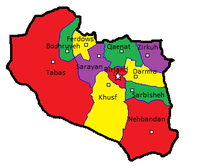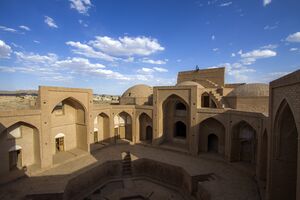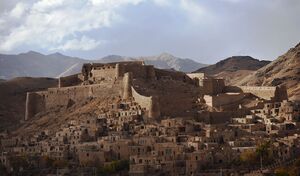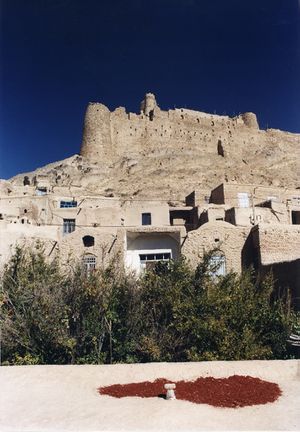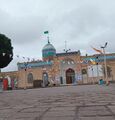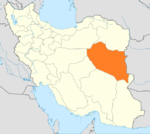محافظة جنوب خراسان
محافظة جنوب خراسان
استان خراسان جنوبی | |
|---|---|
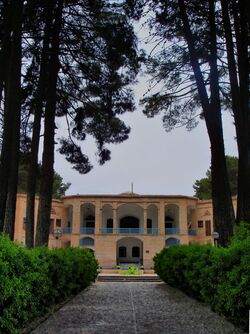 | |
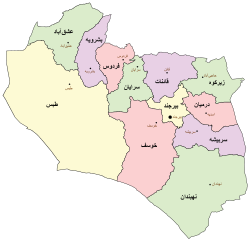 مقاطعات جنوب خراسان | |
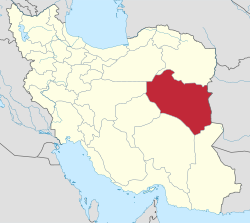 موقع محافظة جنوب خراسان في إيران | |
| الإحداثيات: 32°51′55″N 59°12′59″E / 32.8653°N 59.2164°E | |
| البلد | |
| المنطقة | المنطقة 5 |
| العاصمة | بیرجند |
| المقاطعة | 11 |
| المساحة | |
| • الإجمالي | 69٬555 كم² (26٬855 ميل²) |
| التعداد (2005) | |
| • الإجمالي | 636٬420 |
| منطقة التوقيت | UTC+03:30 (IRST) |
| • الصيف (التوقيت الصيفي) | UTC+04:30 (IRST) |
| اللغات الرئيسية | الفارسية |
| HDI (2017) | 0.757[1] high · 27th |
| الموقع الإلكتروني | sko.ir |
محافظة جنوب خراسان (فارسية: استان خراسان جنوبی)، هي إحدى محافظات إيران وتقع شرق البلاد. عاصمتها مدينة بیرجند. والمدن الرئيسي الأخرى هي فردوس، طبس وقائن.
هذه المحافظة الجديدة، لكنها قهستان القديمة التي كانت تابعة لخراسان الكبرى في التخطيط الادارية الإيراني. إلا أن قهستان تاريخياً كانت تشكل كيان منفصل، بثقافة، تاريخ، وبيئة متميزة.
جنوب خراسان واحدة من ثلاث محافظات تأسست بعد تقسيم خراسان عام 2004. عند تأسيسها، كانت تضم فقد مقاطعة بیرجند، في السنوات اللاحقة تم ضم بعض المقاطعات الجديدة التي انفصلت عن هذه المقاطعة (مثل نهبندان، دارميان وسربیشه)، جميع المدن الشمالية والغربية وأراذي قهستان القديمة (مثل قائن، فردوس، وطبس) ضمت أيضاً لجنوب خراسان.
التاريخ
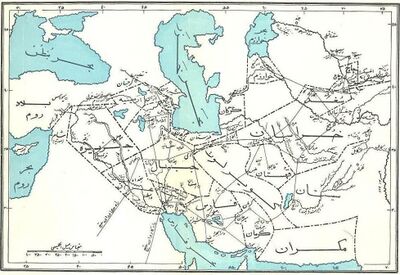
Greater Khorasan has witnessed the rise and fall of many dynasties and governments in its territory throughout history. Various tribes of the Arabs, Turks, Kurds and Turkemen brought changes to the region time and time again. ,[2] Mongols Ancient geographers of Iran divided Iran ("Iran-Shahr") into eight segments of which the most flourishing and largest was the territory of Greater Khorasan. Esfarayen, among other cities of the province, was one of the focal points for the residence of the Aryan tribes after entering Iran.
The Parthian empire was based near Merv in Khorasan for many years. At Parthians times, Esfarayen was one of the important villages of Nishapur.
During the Sassanid dynasty the province was governed by a Spahbod (Lieutenant General) called "Padgoosban" and four margraves, each commander of one of the four parts of the province.
Khorasan was divided into four parts during the Muslim conquest of Persia, each section being named after the four largest cities, Nishapur, Merv, Herat, and Balkh.
In the year 651, the army of Islamic Arabs invaded Khorasan. The territory remained in the hands of the Abbasid clan until 820, followed by the rule of the Iranian Taherid clan in the year 896 and the Samanid dynasty in 900.
Mahmud of Ghazni conquered Khorasan in 994 and in the year 1037 Toghrül, the first of the Seljuq empire rulers conquered Nishapur.
Mahmud of Ghazni retaliated against the invaders several times, and finally the Ghaznavids defeated Sultan Sanjar. But there was more to come, as in 1157 Khorasan was conquered by the Khwarazmids and because of simultaneous attacks by the Mongols, Khorasan was annexed to the territories of the Mongol Ilkhanate.
In the 14th century, a flag of independence was hoisted by the Sarbedaran movement in Sabzevar, and in 1468, Khorasan came into the hands of Tamerlane and the city of Herat was declared as the capital.
In 1507, Khorasan was occupied by Uzbek tribes. After the death of Nader Shah in 1747, parts of it were occupied by the Afghans for a short period.
In these periods, Birjand was a small part of Quhistan which almost encompasses the borders of today South Khorasan. The main cities of Quhistan were Toon (now Ferdows) and Qaen. Birjand grew in recent centuries, especially during the Qajar dynasty and found its important role in this region.
This region was a place of refuge for some movements like the Ismaili, and was the target of Arab refugees who escaped from the tyranny of the Abbasid caliphate. Zoroastrian vestiges also exist in the area.
In 1824, Herat became independent for several years when the Afghan Empire was split between the Durranis and Barakzais. The Persians sieged the city in 1837, but the British assisted the Afghans in repelling them. In 1856, the Persians launched another invasion, and briefly managed to recapture the city; it led directly to the Anglo-Persian War. In 1857 hostilities between the Persians and the British ended after the Treaty of Paris was signed, and the Persian troops withdrew from Herat.[3] Afghanistan reconquered Herat in 1863 under Dost Muhammad Khan, two weeks before his death.[4]
This new province is but the old Quhistan which was included into greater Khorasan in the Iranian administrative planning. However, historically Qohistan forms a separate entity, with a distinct culture, history, environment and ecology.
South Khorasan is one of the three provinces that were created after the division of Khorasan in 2004. While at the beginning, the newly created "South Khorasan" included only Birjand County and some new counties detached from that county (i.e. Nehbandan, Darmian and Sarbisheh), in subsequent years, all northern and western cities and territories of the old Quhistan (such as Qaen, Ferdows and Tabas) have been annexed into South Khorasan, which as of 2016 consists of 11 counties.
Khorasan was the largest province of Iran until it was divided into three provinces on September 29, 2004. The provinces approved by the parliament of Iran (on May 18, 2004) and the Council of Guardians (on May 29, 2004) were Razavi Khorasan, North Khorasan, and South Khorasan.
جنوب خراسان اليوم
التقسيمات الادارية
تضم محافظة جنوب خراسان 11 مقاطعة:
أكبر المدن سكاناً
The following sorted table, lists the most populous cities in South Khorasan.[5]
| الترتيب | المدينة | المقاطعة | التعداد |
|---|---|---|---|
| 1 | Birjand | Birjand | 203,636 |
| 2 | Qaen | Qaen | 42,323 |
| 3 | Tabas | Tabas | 39,676 |
| 4 | Ferdows | Ferdows | 28,695 |
| 5 | Nehbandan | Nehbandan | 18,304 |
| 6 | Boshruyeh | Boshruyeh | 16,426 |
| 7 | Sarayan | Sarayan | 13,795 |
| 8 | Sarbisheh | Sarbisheh | 8,715 |
| 9 | Eslamiyeh | Ferdows | 7,108 |
| 10 | Hajjiabad | Zirkuh | 6,168 |
التعداد
| السنة | تعداد | ±% |
|---|---|---|
| 2006 | 700٬852 | — |
| 2011 | 732٬642 | +4.5% |
| 2016 | 768٬898 | +4.9% |
| amar.org.ir Includes all areas that were not part of the province during the previous censuses | ||
معالم المحافظة
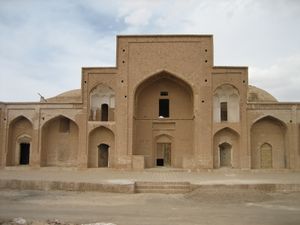
الجامعات والكليات
- جامعة بیرجند
- جامعة بیرجند للعلوم الطبية
- جامعة أزد الإسلامية في بیرجند
- جامعة أزد الإسلامي في فردوس
معرض صور
انظر أيضاً
المصادر
- ^ "Sub-national HDI - Area Database - Global Data Lab". hdi.globaldatalab.org (in الإنجليزية). Retrieved 2018-09-13.
- ^ "Kurds in Khorasan". CSKK. Retrieved 2014-08-12.
- ^ Avery, Peter; Hambly, Gavin; Melville, Charles, eds. (1991). The Cambridge History of Iran (Vol. 7): From Nadir Shah to the Islamic Republic. Cambridge University Press. pp. 183, 394–395. ISBN 978-0521200950.
- ^ Ewans (2002). Afghanistan: A short History of its People and Politics. Perennial. pp. 77. ISBN 006-050508-7.
- ^ "South Khorasan (Iran): Counties & Cities - Population Statistics, Charts and Map". www.citypopulation.de. Retrieved 2021-07-18.
